1-7 Prescot Street
1930-3 extended in 1957–8, offices for the Co-operative Wholesale Society, L. G. Ekins, architect, converted to flats | Part of Co-operative Wholesale Society buildings
CWS Coffee Roasters & Cocoa Works and London Bacon Stoves, 116-118 Leman Street (demolished)
Contributed by Rebecca Preston on March 29, 2019
Early in 1886, following a fire at the end of 1885, the Co-operative Wholesale Society's Tea Department was moved into a former sugar refinery at 116 Leman Street, diagonally opposite the London Branch headquarters. Prior to its use by the English &Scottish CWS, the building was occupied in 1875 by confectioner, Henry Overall, and in 1880 by Augustus William Gadesden, a sugar refiner.1 A seven-year lease was negotiated and approved by the tea committee in August 1886.2 This appears to have been arranged by John Charles Hudson, of Wigg, Oliver & Hudson, architects and surveyors of 80 Leman Street, who also acted for other landowners locally, including Henry Friedlander who owned adjoining property on Chamber Street and in Prescot Street. This was intended to be a temporary arrangement, and in 1887 the tea business returned to the rebuilt warehouses in Rupert Street. However, in August 1886 the committee announced that it proposed shortly to commence manufacturing cocoa, chocolates and essence of coffee at 116 Leman Street and in the next month to spend £2,000 on machinery.3 Strong objections were made to these proposals by some members, including Edward Owen Greening, who had been helping to promote a separate society for the manufacture of cocoa.4 The committee’s proposal was however carried and Mr Cheverall’s tender for the erection of a new chimney was accepted in June 1887 and the following month the committee resolved to buy the remainder of the 99-year lease from an unidentified party.5 By the end of 1887, the Tea, Coffee and Cocoa Department had supplied £312 worth of cocoa (compared with £398,275 worth of tea and £41,143 of coffee in the same year).6 The building had eight storeys and was six bays wide and, together with No. 118, which the CWS would shortly acquire for its bacon stoves, formed a substantial block that incorporated 93 and 94 Chamber Street, where it also had a substantial frontage. As co-operator George Holyoake observed of the Co-operative Wholesale Society’s ‘colossal premises’ in London and Manchester in 1891, at Leman Street was ‘a notable pile of buildings with a considerable cocoa manufactory on the opposite side of the street’.7
The lease of the ‘large warehouse or manufacturing premises’ at 118 Leman Street was advertised in the summer of 1884, when it appears to have been already associated with the neighbouring premises at 93 Chamber Street;8 during the late 1880s and early 1890s the building was occupied by E. H. Hill & Co., wholesale and export confectioners.9 It was converted for bacon stoves by the CWS in c.1896, by which time the two properties were shown as one on the Ordnance Survey.10 In about 1910 both 116 and 118 Leman Street, and 93–94 Chamber Street, were owned by the Duke of Marlborough, from whose agent the property was held by the CWS on 99-year leases from 1885.11 With the exception of a small garage on Chamber Street, this appears to have been the only site within the growing CWS and E&SCWS stronghold locally where the CWS departed from its usual practice of acquiring the freehold.
Following the expansion into 116 Leman Street, the CWS began to look for freeholds to buy on the west side of Leman Street and in December 1886 sought possession of No. 92 for a tailoring workshop and advertised for a competent man as a cutter.12 This house was purchased as part of the block which also included its neighbour, 94 Leman Street, from which the CWS was threatening to evict the tenants in February 1887.13 Although such purchases were intended for immediate or longer-term expansion into purpose-built warehouses and showrooms, a series of successful claims against the CWS for compensation for loss of light and air were costing time and money and the acquisition of property adjacent to the Society’s taller buildings may also have been intended to reduce this burden.14 Some of the purchases, for example from Mrs Cohen of 98 Leman Street, were made on the understanding that previous compensation settlements were to be refunded.15 The houses were then let to tenants until the site was needed for expansion. Thus 94 Leman Street was let to Mr Bannerman for a tailor’s shop in 1888.16 Alternatively, as at 88 and 90 Leman Street, the CWS took leases on strategically placed buildings with the right of ultimate purchase if a property came on the market.[17]
Early in 1886 members of the E&SCWS Tea Committee visited some of the largest chocolate factories in Paris, including that of Percheron & Co., to investigate the equipment required for a cocoa works. During the year, 116 Leman Street was fitted with ‘the most approved machinery’ for the purpose, necessitating ‘extensive alterations’ to the building, which opened for business in 1887;18 the top room was converted for coffee roasting and grinding.19 The cocoa processing machinery was supplied by Percheron (which had premises near City Road, Clerkenwell, as well as in Paris)20 at a cost of more than £900 with a further £549 for installation.21 Unlike coffee roasting, which had previously taken place in the tea department on Rupert Street, cocoa processing was a new departure for the E&SCWS and CWS. As noted above, it proved controversial with some CWS members and, in addition, the story of the cocoa business in Leman Street was ‘mainly one of an uphill fight against the combined advertising and competitive powers of the English and Continental cocoa makers’.22 As a report of a Booth interview with the CWS chocolate department noted in 1895, English chocolate had a tendency to be gritty: ‘There can be little doubt that the foremost French chocolate–cocoa makers are far ahead of us in this branch of confectionery’.23 Discussions about moving the chocolate works out of central London began in 1898 and, after considering several options nationally including Silvertown, new Cocoa Works were finally opened on the edge of Luton in 1902.24 Coffee grinding and roasting continued on site at 116 Leman Street, but these operations appear to have shifted to an extension at the back. In June 1898, ‘our architect, Mr Harris’, presumably F. E. L Harris, was consulted on the rebuilding of 93 Chamber Street, which formed the rear part of the premises recently converted for bacon stoves at 118 Leman Street.25 Shortly afterwards he was asked to draw up plans for extensions to the cocoa works at No. 116.26 By 1910, the latter was an ‘old brick built warehouse in fair repair’, the rear portion rebuilt with a skylight over, and the whole used for furnishing and leather upholstering.27 Plans for 92–93 (and 94) Chamber Street were certified in 1916, which may represent further adaptations.28
Meanwhile the new CWS bacon stoves were opened at the rebuilt 118 Leman Street in 1895–6, on the corner of Chamber Street.[29]Bacon curing had previously been undertaken on a smaller scale within the 1887 branch headquarters building at 99 Leman Street. By 1900, some 2,000 sides of bacon and hams were smoked each week in the new premises.30 In 1912, when the smoking process for each batch took three days, there was capacity for 4,000 sides per week. Green bacon was imported to Leman Street from CWS suppliers in England, Ireland, Denmark and Canada and the CWS factory in Tralee.31 The basement, ground and first two storeys contained the stoves and stores while furnishing and bedding workshops occupied the upper floors.32 At some point in the early 1900s the manufacture of brushes, begun in the early 1890s at the headquarters branch, was moved to 118 Leman Street before the removal of all brushmaking to Leeds in 1904.33 The CWS was particularly proud of its brushmaking enterprise, since it demonstrated that this industry, notoriously associated with sweating in the East End and elsewhere, could be carried on ‘with a profit under fair conditions’.34 By 1912 CWS brushes from the Leeds factory were stored in the London Bacon Stoves building and there were workshops for French polishing in addition to those for upholstery and bedding manufacture.35 Like its neighbour, this too was described in 1910 as an ‘old brick warehouse in fair repair’ but, unlike 116 Leman Street, the central bay in the Leman Street elevation appears to have been adapted with seven loading bays prior to opening. This work is most probably the seven-storey ‘addition to the Co-operative Stores’ by builder, Charles Blake, which was approved in 1890.36 Blake also applied on behalf of the CWS to build a warehouse in Chamber Street in 1893, presumably at the rear.37 ‘Modern premises built fifteen years ago for coffee grinding &c’ were mentioned in the 1910 assessment for 116 and 118 Leman Street and these appear to have been placed across the backs of both premises, with additional access from Chamber Street.38 No. 118 was ‘partially rebuilt’ in 1924.39
Drainage plans indicate 116–118 to be CWS property by 1923, though perhaps still held on a long lease.40 The owner of these two buildings, and their neighbours at Nos 108–14 in the same block between Prescot Street and Chamber Street, was unnamed in the Borough of Stepney Valuation List of 1935, perhaps indicating that the CWS had acquired the freehold as well as being the occupier.41 Ultimately the whole site would be built over, in two stages in 1933 and 1958, by the new CWS Administrative Offices and Bank designed by L. G. Ekins, which is described below. But for the meantime the bacon stoves and coffee works continued in use until at least 1930.42 New CWS bacon stoves were in operation on the east side of Goodman Street by September 1933, suggesting that the old stoves had been abandoned, and perhaps demolished, and the operations transferred prior to the opening of the first phase of the new administrative block, just to their north, in April 1933.43 The old buildings appear to be standing in a CWS illustration recording the adjoining new administrative block at this time but, as noted, these illustrations are not always reliable.44 Nos 116 and 118 had certainly gone by 1945 and the site was temporarily walled in during 1953.45
-
Ancestry, Post Office London Directories, 1875, 1880. ↩
-
National Co-operative Archives (NCA), CWS Minutes, 30 July 1886, 13 August 1886, 20 August 1886; the conveyance was completed the following year, NCA, CWS Minutes, 17 June 1887. ↩
-
NCA, CWS Minutes, 29 February 1886, 30 July 1886, 13 August 1886, 20 August 1886, NCA. ↩
-
Benjamin Jones, Co-operative Production, 1894, p. 237. ↩
-
NCA, CWS Minutes, 20 August 1886, printed insert dated August 1886 in 3 September 1886, and 15 July 1887. ↩
-
21st Anniversary Programme, 1895, pp. 13–14. ↩
-
George Holyoake, The Co-operative Movement To-day, 1891, 1903 edn, p. 41. ↩
-
London Evening Standard, 10 June 1884, p. 7 and 29 July 1884, p. 8. ↩
-
Goad insurance plan, 1889; Post Office London Directories, 1890, 1892. ↩
-
OS map, 1894; CWS Annual, 1896, n.p.; London Metropolitan Archives (LMA), District Surveyors Returns, serial no. 1897.0303. ↩
-
The National Archives (TNA), IR 58/84831 plot nos 4810–11. ↩
-
NCA, CWS Minutes, 3 December 1886, 3 September 1886. ↩
-
NCA, CWS Minutes, 25 February 1887, and printed insert of the London Branch Meeting, 26 February. ↩
-
Great Prescot Street drainage plans, 1–7 Prescot Street and 90 Chamber Street, 1923, Tower Hamlets Local History Library and Archives (THLHLA), L/THL/D/2/30/119. ↩
-
NCA, CWS Minutes, 13 July 1888. ↩
-
NCA, CWS Minutes, 27 July 1888. ↩
-
NCA, E&SCWS, Tea Committee Minutes, 1 August 1895, c.12 November (date obscured), 1895, and 21 November 1895. ↩
-
Opening of the New Premises and Cocoa Works, 1887, p. 31. ↩
-
NCA, CWS Minutes, 25 February 1887. ↩
-
The Chemist & Druggist, 14 March 1885, p. 168. ↩
-
NCA, CWS Minutes, 25 March 1887. ↩
-
Story of the C.W.S., p. 178. ↩
-
Notebook: Confectioners, [Published in 2nd series – industry. Vol 3. Part II. Ch .3], Interview with Cooperative Wholesale, chocolate department, Leman Street, n.d., c.1895, London School of Economics, BOOTH/B/129, pp.35–41. ↩
-
Percy Redfern, Story of the C.W.S., 1913, p. 178; ‘Luton Cocoa and Chocolate Works’, CWS Annual, 1912, n.p. ↩
-
NCA, E&SCWS Tea Committee Minutes, 20 June 1898. ↩
-
NCA, E&SCWS Tea Committee Minutes, 11 July 1898. ↩
-
TNA, IR 58/84831 plot nos 4810–11. ↩
-
LMA, DSR Serial nos 1916.0007–8, ↩
-
21st Anniversary Programme, 1895, p. 9, NCA, CSH CWS(P) Box 2; LMA, DSR serial no. 1897.0303; CWS Annual, 1896, illustration, n.p. ↩
-
CWS Annual, 1900, p. 12. ↩
-
CWS Annual, 1912, n.p. ↩
-
TNA, IR 58/84831 plot nos 4810–11. ↩
-
21stAnniversary Programme, 1895, p. 10; Story of the C.W.S., p. 319. ↩
-
21stAnniversary Programme, 1895, p. 10. ↩
-
CWS Annual, 1912, n.p. ↩
-
LMA, DSR serial no. 1890.0058. ↩
-
LMA, DSR serial no. 1893.0236. ↩
-
TNA, IR 58/84831 plot nos 4810–11: Great Prescot Street drainage plans, 1923, THLHLA, L/THL//D/2/30/119. ↩
-
LMA, DSR serial no. 1924.1034. ↩
-
Great Prescot Street drainage plans, 1923, THLHLA, L/THL/D/2/30/119. ↩
-
Metropolitan Borough of Stepney Valuation List, 1935, THLHLA, L/SMB/C/1/3. ↩
-
CWS property plan, 19 November 1930, LMA, GLC/AR/BR/17/45017. ↩
-
CWS Bacon Stoves, proposed tunnel under Rupert [Goodman] Street, 18 September 1933, LMA, GLC/AR/BR/17/45017. ↩
-
London Branch of the CWS, 1933, p.7. ↩
-
Goad insurance plan, 1945; THLHLA Building Control file, 23212, 1 Prescot Street. ↩
Co-operative Wholesale Society Administrative Offices and Bank, 1 Prescot Street
Contributed by Rebecca Preston on March 29, 2019
Leonard Gray Ekins, FRIBA (1877–1948) worked all his adult life for the Co- operative Wholesale Society and served as London Branch Chief Architect from 1916 to 1942.1 In 1898–1903 he was assistant architect under F. E. L. Harris at Manchester and confirmed as Newcastle’s Branch Architect in 1905.2 Like Harris, Ekins employed the Hennebique system of reinforced concrete in his larger projects, including the Dunston-on-Tyne soap works (1907–9, extended 1911–14).3 He was placed in charge of the new branch Architects’ Department, which covered London, the South of England and South Wales, in 1916, and appears to have been based initially at 99 Leman Street.4 In his early years in Whitechapel Ekins seems principally to have been involved with planning alterations to the block on the west side of Leman Street (Nos 108–118), which housed the coffee works and bacon stoves, but was doubtless also at work on more ambitious projects. Demolitions had already begun on the north side of this block, in 1912 if not before, with a former restaurant at the corner with Prescot Street. By January 1913 the CWS had erected a temporary single-storey iron building for use as offices in its place and renumbered the plot 1 Prescot Street, presumably with a more impressive building in mind for the future.5 The demolition of the neighbouring houses at the corner of Prescot Street took place at around the same time. Ekins made plans in 1923 for a series of temporary covered workshops and garages, which extended south behind the bacon stoves and coffee works at 116–118 Leman Street, with an entry created by the demolition of the house at 90 Chamber Street. But this work seems not to have been executed and no further building appears to have taken place on this site until preparations for the new Administrative Offices and Bank in about 1930.6
The impressive building now known as 1 Prescot Street is probably L. G. Ekins’s best-known London work. This steel-framed office block, with dramatic, cliff-like elevations above its artificial granite base, looms over Leman Street and Prescot Street, where it occupies a prime position on the south- west side of the crossroads, nearly opposite the site where the London Branch had begun in 1881. At the opening of the first section of the Administrative Offices in 1933, CWS publicity explained how, on the east side of Leman Street, No. 99 was in a line of buildings that continued for 514 feet, while on the other side the headquarters of the E&SCWS extended for 331 feet. Street directories capture the spread of the two societies along Leman Street – the CWS at 53 & 55 and 99 on the east side and 82, 116, 118 and 130, and the E&SCWS at 100 Leman Street on the west.7 To the CWS at least, this provided further evidence of the almost seamless ‘Co-operative Advance along Leman Street’.8 But to some, the range of architectural styles was now bewildering. An article in Building by architect Frederic Towndrow described the impact made by Ekins’s new Administrative Offices in comparison with its older CWS neighbours:
'After wandering through this unpleasant part of London, one comes upon it with a shock of pleasant surprise. Its adjacent buildings, also belonging to the Co-operative Society and designed several years ago, are frankly awful. Here in such low company is one of the most interesting and beautiful buildings erected in England in recent years. In contrast with work of a similar kind, which was being done a few years ago, here is food for optimism and faith in the human race. The building has spirit, it has urge, and a sense of grand advancement.'9
In 1930 Ekins had travelled to Germany and Holland with CWS Architects W. A. Johnson, FRIBA (from Manchester) and W. G. T. Gray (Newcastle-upon-Tyne) to study ‘modern architecture’, which CWS historian Percy Redfern took as a sign of how the CWS kept pace with ‘the revolutionary change since the war in the outlook of the [architectural] profession’.10 Towndrow was unconcerned as to whether the new administrative block was ‘modern, or functionalist, or English, or Dutch or merely original’ but thought it had ‘some life and power in it’.11 It has been heralded since as ‘a riot of German Expressionist and Wrightian motifs’, with ‘rugged Amsterdam-School style Expressionist brickwork’.12 As Teresa Pinto points out, in openly embracing this new style from the Continent, the CWS was doing more than just following fashion: ‘it was also celebrating its role within the international co-operative movement, in which it conceptualised itself as the leading player’.13 Ekins’s undated elevation drawings for the new block were received by the LCC in July 1929 and show the design as executed, with contrasting textured spandrel panels, spiny antefixae and other detailing, which indicate that, even before his tour of Europe in 1930, he already had such a building in mind.14
The approved drawings covered the complete development of the six-storey Administrative Offices on the Prescot Street, Leman Street and Chamber Street sites but it was executed in two planned stages; like the tea warehouse, which opened in 1897 and subsequent E&SCWS and CWS buildings, the building was executed in-house by the CWS Building and Engineers’ Departments. The first portion, on the north side of the block between Prescot Street and Chamber Street, was opened formally in April 1933 and contained the CWS Bank on the ground floor. Although Ekins’ drawings of around 1929 indicate that he proposed to add the double-height mansard at a later date, and CWS board minutes of February 1930 discuss the cost of planning for two extra floors, photographs of May 1933 appear to show the first phase of the building, fronting Prescot Street and the corner of Leman Street, completed to full height.15 Unless it was retrospective, it is therefore not clear what was meant by the ‘addition of fifth and sixth floors with alterations’ itemised in district surveyors’ returns of 1936.16
When both phases were complete, the building was designed to hold 500 people and it was proposed that the Architects’ Department, and the Engineers’ and Building Departments, would be housed in ‘happy unity’ on the two upper floors.17 The Architects’ Department designed the retail stores as well as the Wholesales’ premises and in 1933 a total of 800 architectural, engineering and building staff based at branch offices in England and Wales were to be supervised from the new Administrative Offices.18 The CWS highlighted the symbolism of having frontages in both Leman Street and Prescot Street – Leman Street, with the entrance to the Bank, being a ‘co-operative colony’, while Prescot Street was ‘the thoroughfare that leads to the Tower of London, the Royal Mint, and the great City itself’.19
The new Bank – ‘the clearing house’ of the Co-operative movement – had three times more floorspace than in its former home at 99 Leman Street, where it had opened in 1920 with ‘only 441 current and deposit accounts’.20 The panel above the Prescot Street entrance, depicting a naked man and woman grasping a wheatsheaf staff beneath a beehive to symbolise co-operation, was designed by J.C. Blair, the brother of a late director of the CWS.21 An underground tunnel connected the new building with the London Tea Department on the north side of Prescot Street.22 There were now nearly 2,957 CWS employees in and about Leman Street with a further 978 working for the E&SCWS at Leman Street, the bonded warehouses at Middleton’s Wharf, Wapping, and the chocolate factory at Luton.23
Although the CWS had claimed in 1930 that, ‘compared with northern grime, Whitechapel was the high street of an old-world country town’,24 the effects of urban pollution on Ekins’s London exteriors may perhaps have influenced CWS practice in Manchester. Similarly dentilated brickwork in contrasting panels was in the late 1930s also employed by the CWS Architects’ Department in Manchester, for example at the new Menswear Department and Drapery Warehouse, which opened at the end of 1939. It was reported that the buff and blue brickwork and reconstructed stone dressings had been chosen ‘with a view to survival from the more murky effects of a drab climate’.25 When the first portion of the London Administrative Offices was opened in 1933, the promotional booklet insisted that while Balloon Street, Manchester, ‘retains its historic position in the CWS; Leman Street affords evidence of the conquering power of co-operation in the Capital City of Empire’.26
The second portion of the administrative block was undertaken in 1957–8, thereby completing Ekins’s suite of Expressionist blocks on the west side of Leman Street; the Leman Street entrance was moved further to the south than originally conceived and the return building line on Chamber Street was also modified.27 Other than the three-bay side return on Chamber Street, where Ekins’s seven-storey wing ended, the elevation flanking Chamber Street (which was rarely photographed) was one-storey high above the plinth.28 This was described in 1957 as ‘partial development’, and thus represented a curtailment of Ekins’s original four-storey design for the south side of the block.29 Plans of around 1929 show a dining room on the ground floor, with a double- height meeting hall and staff gymnasium on the unexecuted storeys above.30 An extension was added in 1960 to the Chamber Street front at second-floor level, near the private link road between Prescot Street and Chamber Street, but otherwise the exterior fronting Chamber Street was not altered significantly until after 1973.31 Like other CWS and E&SCWS premises locally, the whole administrative office complex was arranged around an open area which served as light well and yard, entered in this case from the link road. This link road was eventually bridged with a foot passage above second floor on the Prescot Street frontage, in order to connect with Ekins’s furnishing warehouse of 1939. Inside the administrative block, ‘Empire hardwoods’ were used throughout and the completed building contained a double- height boardroom and directors’ dining room, in addition to the banking hall and associated offices.32
Now known as 1 Prescot Street, the Administrative Office and Bank were generally known as 110 Leman Street and 1 Prescot Street (but were still addressed with their original numbering of 108–118 Leman Street and 1–9 Prescot Street by the GLC in 1973).33 In 1968 ‘alterations to form offices’ were agreed to the sixth floor ‘Ex Architects’ Department’.34 Changes in the 1970s included a new CWS Travel Bureau on the ground floor with a basement adaptation for a bullion room.35 A total refurbishment was carried out for the CWS in 1985.36 It was presumably at this time that the single-storey elevation along Chamber Street was carried up to the height of the Leman Street front and capped with a projecting attic, since drawings of 1995 showing the present Chamber Street elevation proposed removing the ‘existing windows’ above the first floor with decorative metal grilles to vent car parking areas on the ground, first and second storeys.37 In 1995 IKA Project Design & Management submitted plans for a proposed conversion from offices to residential accommodation with 115 units on behalf of CWS Property, with landscaping and associated works.38 After these were passed in mid-1996, a representative from Rialto Homes Plc attended the meeting between the architects and the District Surveyor to discuss a fire strategy for the accepted scheme. Later the same year, by which time the CWS was not mentioned in building control or planning correspondence, Rialto Homes submitted a revised scheme. Permission was sought and granted for the refurbishment, change of use and conversion from offices and ancillary uses, to create a gym at basement level, 150 residential units on floors one to seven (including four residential units at roof level), and car parking and cycle storage at lower ground, ground and new mezzanine floor levels (i.e., no carparking above the first floor as originally planned).39 Present use, and plans by Rialto’s architects for the conversion, Denton Corker Marshall Ltd, indicate commercial units on the ground-floor Leman Street and Prescot Street fronts.40 The building and its railings were listed Grade II in 1990.
-
‘Obituaries’, RIBA Journal, September 1948, p. 519: Percy Redferen, Story of the C.W.S., 1913, p. 325. ↩
-
Lynn Pearson, Architecture of the Co-operative Movement, draft Chapter 4, p. 2. ↩
-
Pearson, draft Chapter 4, p. 3: Michael Stratton and Barrie Trinder, Twentieth Century Industrial Archaeology, 2000, 2013 edn., pp. 13, 46; CWS Annual, 1915, p. 121. ↩
-
Royal Institute of British Architects, L. G. Ekins RIBA nomination papers, 5 November 1920; ‘CWS Architects’ Activities’, The Producer, November 1924, p. 17. ↩
-
Photograph of the CWS Tea Department, The Wheatsheaf, January 1913, p. 103: Tower Hamlets Local History Library and Archives (THLHLA), Great Prescot Street drainage plans, 1 Prescot Street, 25 November 1915. ↩
-
Great Prescot Street drainage plans, 1/7 Prescot Street and 90 Chamber St, 1923, THLHLA, L/THL//D/2/30/119: London Metropolitan Archives (LMA), District Surveyors Returns serial no. 1923.0301. ↩
-
Ancestry, Post Office Directory, 1932, p. 431. ↩
-
London Branch of the CWS, 1933, p. 21. ↩
-
Frederic E. Towndrow, ‘Current Architecture’, Building, July 1933, p. 282. ↩
-
New History of the C.W.S., 1938, p. 423. ↩
-
Towndrow, ‘Current Architecture’, Building, July 1933, p. 282. ↩
-
Elain Harwood, Historic England Archives, London Historians File TH 137; https://britishlistedbuildings.co.uk/101065738-number-1-prescot-street- and-attached-wall-and-railings-whitechapel-ward#.XHk9O9HgpN0; Bridget Cherry, Simon Bradley, Charles O’Brien, Nikolaus Pevsner, London: East, 2005, p. 436. ↩
-
Teresa Pinto,An Architectural History of the Co-operative Movement in London, 1916–1939, unpublished MA dissertation, UCL Bartlett School of Architecture, 2015, p. 8. ↩
-
LMA, GLC/AR/BR/19/3339. ↩
-
THLHLA, Building control file, 22378, 110 & 1–7 Prescot Street; 110–20 Leman Street plans (large), LMA, GLC/AR/BR/19/3339; information on CWS board minutes from Lynn Pearson; Architectural Review, 24 May 1933, p. 692. ↩
-
LMA, DSR serial no. 1936.1338-48. ↩
-
_London Branch of the CWS, _1933, pp. 24, 31. ↩
-
Ibid. ↩
-
Ibid., p. 21. ↩
-
Ibid., p. 27. ↩
-
Ibid., p. 22. ↩
-
LMA, DSR serial no. 1931.1281; CWS property plan, 1934, LMA, GLC/AR/BR/17/077326/02. ↩
-
London Branch of the CWS, 1933, p. 31. ↩
-
‘Sunshine in London: East and West by a Wheatsheaf Observer’, The Wheatsheaf, February 1930, p. 23. ↩
-
‘Manchester’s Splendid new Service Centre’, The Producer, November 1939, p. 326. ↩
-
London Branch of the CWS, 1933, p. 23. ↩
-
Correspondence in THLHLA, Building control file, 22378, 110 & 1–7 Prescot Street. ↩
-
Photograph, 1973, LMA, SC/PHL/01/392/73/10920. ↩
-
THLHLA, Building control file, 22378, 110 & 1–7 Prescot Street. ↩
-
110–20 Leman Street plans (large), 1929, LMA, GLC/AR/BR/19/3339. ↩
-
Ibid; Photograph, 1973, LMA, SC/PHL/01/392/73/10920. ↩
-
London Branch of the CWS, 1933, pp. 15, 21; LMA, GLC/AR/BR/19/3339. ↩
-
THLHLA, Building control file, 22378, 110 & 1–7 Prescot Street. ↩
-
THLHLA, Building control file, 23212, 1 Prescot Street. ↩
-
THLHLA, Building control files, 22378, 110 & 1–7 Prescot Street and 23212, 1 Prescot Street. ↩
-
Minutes of meeting with District Surveyor, 1996, THLHLA, Building Control file, 26731, 1 Prescot Street. ↩
-
THLHLA, Building control file, 22378, 110 & 1–7 Prescot Street. ↩
-
Proposed refurbishment by IKA Design and Management, 1995, THLHLA, Building control file, 26731, 1 Prescot Street; Tower Hamlets planning applications online, Listed Building Consent (S8 P&LBC 1990), 1996. ↩
-
Tower Hamlets planning applications online, WP/96/00217, 1996. ↩
-
THLHLA, Building control file 26731, 1 Prescot Street. ↩
Social, political and cultural activity in the Co-operative Wholesale Society's premises in and around Leman Street
Contributed by Rebecca Preston on March 29, 2019
From its early days the Co-operative Wholesale Society organised social and educational activities for its staff and hosted meetings and other events, and later on leased property to co-operative and other organisations with whom it shared interests and values. At the suggestion of Mrs Benjamin Jones, wife of the London Branch manager, the first meeting of the Women’s Co-operative Guild took place at Hooper Square on 15 April 1886, attended by over seventy women and chaired by co-operative worker Catherine Webb.1 Representatives from Toynbee Hall had been present at the opening of the new headquarters building in 1887 and from at least 1885 the settlement had put on lectures for CWS workers at Hooper Square and also held classes for co-operators at Toynbee Hall.2 A library for employees was formed at the London Branch, not long after the fire had destroyed the premises in late 1885, when board meetings were transferred temporarily to Toynbee Hall.3 When Prof Sedley Taylor started a class in economics at Toynbee Hall, CWS staff were said to have formed the nucleus of his students.4 The Wholesale considered itself a beacon in the East End, its architectural presence drawing attention to its work in the promotion of co-operation, and provided office space for kindred organisations. Thus in the late 1880s and 1890s, 99 Leman Street was the address of the Co-operative Aid Association, the Tenant Co-operators Society, and the People’s Co-operative Society. No. 99 Leman Street also hosted public lectures on co-operative and related themes. A course of twenty university extension lectures was offered on the life and duties of the citizen on Saturday afternoons in 1893, held after the working week had finished at 4 o’clock on Saturdays in the Conference Hall. These were free to co-operators and 5s (or 2s 6d for the half course of ten) to the general public.5 In 1901, the Countess of Warwick presided at a conference at London Branch headquarters on London School Board Evening Continuation Classes.6
During the Co-operative Wholesale ‘tea girls’ strike’ over piecework at the tea department in 1904, Canon Barnett offered the women a room at Toynbee Hall while he opened negotiations between the CWS and the Women’s Trade Union League.7 In the 1930s, Toynbee Hall organised for parties of undergraduates and public school children to be taken around CWS premises locally.8 By the 1920s, in addition to the various departments and bank, 99 Leman Street was also home to the CWS Financial Propaganda Department, CWS Social Club, the Co- operative Press Agency and the Russo-British Co-operative Information Bureau.9 London Branch employees’ activities on site included a fine art club, with ‘notable exhibits of painting and sculpture from Leman Street’ being shown in the 1930s at the East End Academy in the Whitechapel Art Gallery.10 An Ethiopian Exhibition organised by Sylvia Pankhurst on behalf of the Princess Tsahai Memorial Hospital Fund, of which Pankhurst was the honorary secretary, was displayed during 1948 in the Boot and Shoe Showrooms at 99 Leman Street. Ancient Ethiopian traditional dress, embroidery, leather- work and illuminated books appeared alongside examples of modern textiles. This formed part of a project to form closer relations with ‘the brave Ethiopian people whose struggle against the aggression of Mussolini aroused sympathy and interest in this country’. A film, ‘This is Ethiopia’, was shown in the CWS film theatre at the Tea Office across the road in Prescot Street.11
-
Catherine Webb, The Woman with the Basket: The History of the Women’s Co-operative Guild, 1883–1927, 1927, p. 28. ↩
-
‘Opening of new Co-operative Premises in Whitechapel’, East London Advertiser, 5 November 1887, p. 7; Asa Briggs and Anne Macartney, Toynbee Hall: The First Hundred Years, 1984, p. 45. ↩
-
National Co-operative Archive (NCA), CWS Minutes, 29 February 1886. ↩
-
London Branch of the CWS, 1933, p. 30. ↩
-
Co-operative Union Southern Section, A Course of Twenty University Extension Lectures…, 1893, [p. 1]. ↩
-
‘Knowledge or Ignorance’, Sunday Times, 24 March 1901, p. 8. ↩
-
‘Co-operative Wholesale Girls’ Strike’, London Daily News, 12 October 1904, p. 8. ↩
-
Correspondence with the Co-operative Wholesale Society, Leman Street, re visit by Toynbee Hall students, November 1937, London Metropolitan Archives (LMA), A/TOY/015/002/047–048. ↩
-
Daily Herald, 1 January 1921, p. 6; CWS Annual, 1918, p. 289; People’s Yearbook, 1921, p. 377; The Producer, July 1925, p. 266. ↩
-
New History of the C.W.S., 1938, p. 506. ↩
-
‘Ethiopian Exhibition’, The British Journal of Nursing, July 1948, p. 85. ↩
The Co-operative Wholesale Society around Leman Street and its beginnings in London
Contributed by Rebecca Preston on March 29, 2019
The Co-operative Wholesale Society (CWS) opened its first warehouse in Whitechapel in 1881, on a plot on the north side of the present Hooper Street, just to the east of Leman Street. Very quickly, as CWS business expanded, the organisation bought up and built on neighbouring plots and by the 1930s this corner of Whitechapel was home to a series of impressive warehouses, offices, factories, showrooms and a bank, which flanked Leman Street and surrounding roads. Designed by CWS architects and engineers, many of the buildings in what became a Co-operative Wholesale colony have now gone and what remains has mostly been converted to apartments. Of the original warehouse built in 1879–1881, only the stair tower survives, a yellow-brick column to the rear of the CWS London Branch headquarters building at 99 Leman Street, which opened in 1887. That and some of its CWS successors still dominate the vicinity, not without a degree of architectural spectacle.
The Co-operative Wholesale Society – now The Co-operative Group – was founded in Manchester in 1863, to supply basic foodstuffs and daily necessities wholesale to Co-operative retailers. The wholesale society was a federal organisation, owned by the retail societies it traded with, and sought to integrate production and distribution in order to lower costs. As is well known, the co-operative principle of mutual benefit was established in 1844 by the Rochdale Equitable Pioneers’ Society, many of whose members had backgrounds in earlier co-operative, communitarian and socialist ventures.1 From around the mid-century, efforts were made to set up a central wholesale agency, culminating in what became the CWS.2 It began as the North of England Co-operative & Wholesale Industrial Society Ltd and expanded rapidly to serve the growing number of retail societies in England and Wales. When it became impossible to serve these from Manchester alone, subsidiary wholesale branches were set up in Newcastle-upon-Tyne in 1871 and in London in 1874. 3 London was considered difficult terrain, a ‘co-operative desert’ in need of irrigation and the story of the struggle to gain a foothold in the capital was characterised in 1913 as ‘the attack on London’.4
The CWS aimed to procure unadulterated goods at low prices, by ‘eliminating the middle-man and his profits’ rather than economising on labour.5 Beginning with butter, which accounted for a third of sales in the first decade, the CWS built a network of buyers, suppliers and, crucially, depots, which facilitated bulk purchasing and centralised processing in order to secure the best prices and quality.6 The co-operative principle of avoiding middlemen also underlay the Society’s policy in London of, wherever possible, purchasing the freeholds of its premises, ‘for co-operators, being prudent men, have a righteous horror of the short leasehold system’.7 Thus the CWS and a little later the English & Scottish Joint CWS (E&SCWS) became significant landowners in Whitechapel.
The first London Branch premises opened in 1874 at 118 Minories, a warehouse backing onto America Square on the eastern edge of the City of London. This was convenient for the docks and for markets, in particular Mincing Lane in the City, which was the centre of the international tea trade from the 1830s. The London Public Tea Auction, held in the London Commercial Sale Rooms at Mincing Lane, was established in 1834 after the dismantling of the East India Company monopoly.8 Tea fit with the temperance beliefs of many early co- operators and from the foundation of the Wholesale Society formed an important CWS commodity; it remained so as consumption of tea increased nationally, only levelling off in the 1940s.9 Within a few years of opening in London the business had outgrown the space available and the CWS began to look for larger premises. ‘Great difficulty was found in selecting a freehold site which would be at once convenient for the various markets and the railways’ but by the end of the 1870s a site in Whitechapel had been decided upon and in 1881 new London Branch premises were opened near Leman Street, less than half a mile east of the Minories.10 As the Society consistently pointed out to its members, Leman Street was both the highway to the docks and ‘conveniently adjacent’ to bonded tea warehouses.11 The premises were also keenly positioned within the railway network and bordered on the site of the future London, Tilbury & Southend Railway (Commercial Road) goods depot and its vast warehouses, which, when it opened in 1886, provided a link to the East & West India Dock Company’s new dock at Tilbury.12
-
Lynn Pearson, Architecture of the Co-operative Movement, draft Chapter 1: Laying the Foundations: Retail Societies, 1844–1890, 2018, p. 2. We are grateful to Lynn Pearson for help with this account. ↩
-
Pearson, Architecture of the Co-operative Movement, draft Chapter 2: Pioneering Production: CWS Depots and Factories, 1863–1897, p. 2. ↩
-
Anthony Webster, ‘Building the Wholesale: The Development of the English CWS and British Co-operative Business 1863–90’, Business History, 54(6), 2012, pp. 883–904, p. 894. ↩
-
Co-operative Wholesale Society Limited, London Branch, Opening of the New Premises and Cocoa Works, 1887, p.54; Percy Redfern, The Story of the C.W.S. The Jubilee History of the Co-operative Wholesale Society Limited, 1913, p.83; Webster, ‘Building the Wholesale’, p. 885. ↩
-
A. D. Harrison, ‘Review of The Story of the C.W.S. by Percy Redfern’, Charity Organisation Review, New Series, Vol. 35, No. 205 (January 1914), pp. 46–8, p. 46. ↩
-
Pearson, draft Chapter 2, p.1. ↩
-
Opening of the New Premises and Cocoa Works, p. 70. ↩
-
Markman Ellis, Richard Coulton and Matthew Mauger, Empire of Tea: The Asian Leaf that Conquered the World, 2015, p.249. ↩
-
Bishnupriya Gupta, ‘The History of the International Tea Market, 1850–1945’, EH.Net Encyclopedia, ed. Robert Whaples, 16 March 2008: https://eh.net/encyclopedia/the-history-of-the-international-tea- market-1850-1945/. ↩
-
Opening of the New Premises and Cocoa Works, 1887, p. 9 ↩
-
‘CWS: Tea Growers, Blenders, and Packers II’, The Wheatsheaf, February 1908, p. 120. ↩
-
Tim Smith,‘Commercial Road Goods Depot, Whitechapel’, Greater London Industrial Archaeology Society, 1979,re-typed with annotations, January 2000: http://www.glias.org.uk/journals/2-a.html. ↩
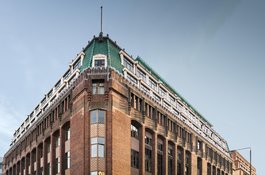
1-7 Prescot Street, former Co-operative Wholesale Society offices
Contributed by Chris Redgrave
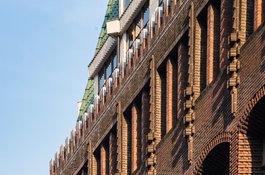
1-7 Prescot Street, former Co-operative Wholesale Society offices
Contributed by Chris Redgrave
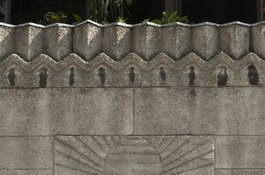
1-7 Prescot Street, overdoor sculpture in 2017
Contributed by Derek Kendall
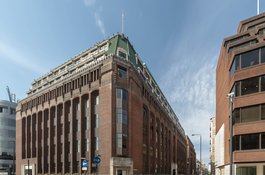
1-7 Prescot Street, former Co-operative Wholesale Society offices, from the northeast in 2019
Contributed by Derek Kendall

1-7 Prescot Street, doorway detail
Contributed by Derek Kendall
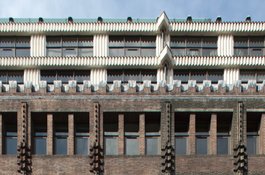
1-7 Prescot Street, elevational detail
Contributed by Derek Kendall
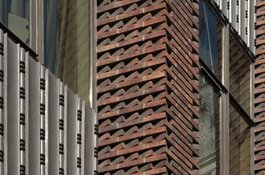
1-7 Prescot Street, brickwork detail
Contributed by Derek Kendall
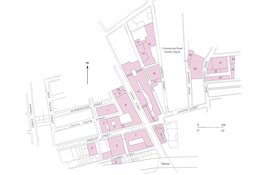
The Co-operative Wholesale Society estate in 1968
Contributed by Helen Jones